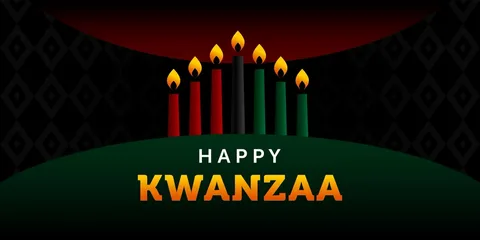Happy Kwanzaa is a special time of year when families and communities come together to celebrate African-American heritage, reflect on the Seven Principles of Kwanzaa, and embrace unity. From December 26 to January 1, millions of people observe this cultural holiday to honor African roots, foster community building, and embrace the significance of family values. Whether you are looking for gift ideas, planning a Kwanzaa celebration, or learning about Kwanzaa symbols, this guide will provide the essential information to make your observance meaningful and impactful.
What is Kwanzaa?
Happy Kwanzaa is a non-religious, cultural celebration that honors the history and achievements of African-American culture. It was created by Dr. Maulana Karenga in 1966 and serves as a time for reflection, cultural pride, and community unity. Celebrated each year from December 26 to January 1, Kwanzaa is a reminder of the power of collective effort and personal commitment to family values and African heritage.
Kwanzaa Greetings: Saying “Happy Kwanzaa”

When celebrating Kwanzaa, one of the most common and heartfelt ways to greet others is by saying “Heri za Kwanzaa,” which translates to “Happy Kwanzaa” in Swahili. Sharing this greeting with friends, family, and loved ones is an essential part of the holiday, reinforcing the spirit of unity and joy. Other meaningful Kwanzaa greetings include:
- Habari Gani? (How are you?)
- Harambee! (Let’s pull together!)
Saying “Happy Kwanzaa” reflects the core message of the holiday, which is about coming together in harmony and celebrating the collective strength of the African-American community.
The Seven Principles of Kwanzaa (Nguzo Saba)
A major focus of Happy Kwanzaa is the Seven Principles of Kwanzaa (Nguzo Saba), which guide individuals toward a more meaningful life. Each day of Kwanzaa is dedicated to one of these principles, which are essential to building a vibrant, strong community. Let’s dive into the principles that are celebrated each day of Kwanzaa.
1. Umoja (Unity)
The first day of Kwanzaa celebrates Umoja, or unity. This principle encourages people to work together and support one another, whether in their family, community, or beyond. By promoting unity, we help strengthen our bonds and create a harmonious environment for everyone.
2. Kujichagulia (Self-Determination)
Kujichagulia stands for self-determination. It is about taking control of our own destiny, defining who we are, and empowering ourselves to make decisions that benefit our future. This principle is a powerful reminder to act with purpose and embrace individual autonomy.
3. Ujima (Collective Work and Responsibility)
Ujima emphasizes collective work and responsibility. This principle encourages individuals to work together to improve their community, share resources, and lift each other up. It underscores the idea that we are stronger together and must contribute to the well-being of everyone around us.
4. Ujamaa (Cooperative Economics)
Ujamaa focuses on cooperative economics. This principle encourages people to support one another by investing in local businesses, sharing resources, and creating financial opportunities within the community. It is about creating a strong economic foundation that benefits everyone.
5. Nia (Purpose)
Nia, meaning purpose, is a principle that reflects on our reason for living and the contributions we can make to the world. It encourages people to live with intention, setting goals that benefit not only themselves but also their families and communities.
6. Kuumba (Creativity)
The principle of Kuumba celebrates creativity. On this day, families and communities are encouraged to express themselves artistically, whether through music, dance, art, or any form of creative expression. Kuumba reminds us of the power of creativity to transform lives and inspire others.
7. Imani (Faith)
The final day of Kwanzaa honors Imani, which means faith. This principle reflects the importance of faith in family, community, and culture. It encourages individuals to have faith in their collective future and the strength of their heritage.
Symbols of Kwanzaa
The symbols of Kwanzaa help deepen our connection to the Seven Principles and enhance our celebration of African-American culture. These symbols are displayed throughout the holiday, helping to remind us of the significance of each principle. Here are the key Kwanzaa symbols you should know about:
Kinara (Candleholder)
The Kinara, or candleholder, holds the seven candles representing the Seven Principles of Kwanzaa. The colors of the candles red, green, and black are symbolic of the Pan-African flag, with each color representing an important aspect of the celebration.
Mkeka (Mat)
The Mkeka is a straw mat that serves as the base for the other symbols of Kwanzaa. It represents the foundation of our heritage and the strength of our culture. Without a strong foundation, there can be no growth or unity.
Mazao (Crops)
Mazao, or crops, symbolize the abundance of the harvest and are displayed as a reminder to give thanks for the fruits of our labor and the blessings in our lives. The crops remind us to appreciate the earth and the community that sustains us.
Kikombe cha Umoja (Unity Cup)
The Unity Cup is used to honor ancestors and symbolize togetherness. It is shared during the Kwanzaa celebration, promoting unity and a sense of collective strength.
Zawadi (Gifts)
On the final day of Kwanzaa, families exchange Zawadi, or gifts, to represent the importance of nurturing and educating the younger generation. These gifts are often educational or creative in nature, encouraging learning and personal growth.
Kwanzaa Foods and Feasts
The Kwanzaa feast, or Karamu, takes place on December 31 and is an important aspect of the celebration. The meal includes traditional African-American dishes, representing the richness of African heritage. Foods like Caribbean Sorrel, Dates, Figs & Milk, and African-inspired recipes are commonly served, reflecting the bounty of the harvest and the spirit of community unity.
The Karamu is not just a feast but a time for family bonding, storytelling, and celebrating the year’s achievements. It is an opportunity to gather around the table, share food, and reaffirm the values of community, love, and gratitude.
Educational Resources and Kwanzaa for Children
Kwanzaa is a wonderful time to teach children about their African heritage and the importance of family values. There are many educational resources available for parents and educators to help children learn about the Seven Principles and the symbols of Kwanzaa.
From Kwanzaa crafts to Swahili activities, there are numerous ways to engage children in the holiday celebrations. Whether creating their own Unity Cup or learning about the significance of Mazao (crops), these activities help children connect with the cultural meaning of Kwanzaa.
Conclusion
Happy Kwanzaa is a time to celebrate African-American culture, honor family values, and reflect on the importance of community. By embracing the Seven Principles of Kwanzaa, engaging in symbolic rituals, and enjoying time with loved ones, you can make this holiday meaningful and impactful. Whether you are lighting the Kinara, exchanging Zawadi, or sharing a meal, Kwanzaa is a powerful reminder of the strength found in unity, creativity, and faith.
Celebrate Kwanzaa with love and unity! Embrace the traditions, light your Kinara, and come together with family. Wishing you a joyous and purposeful holiday. Happy Kwanzaa! Visit us at Pen to Press Publication for more!
FAQs
What is the meaning of Kwanzaa?
Kwanzaa is a cultural holiday that celebrates African-American heritage, family values, and community unity. It is based on the Seven Principles of Kwanzaa, which encourage self-determination, creativity, and cooperative economics.
How do you say “Happy Kwanzaa” in Swahili?
To say “Happy Kwanzaa” in Swahili, you would say “Heri za Kwanzaa.” This greeting is a way to share the joy and spirit of the holiday with others.
What are some traditional Kwanzaa foods?
Traditional Kwanzaa foods include dishes like Caribbean Sorrel, Dates, Figs & Milk, and other African-inspired recipes. These foods symbolize the harvest and the blessings that come with it.

